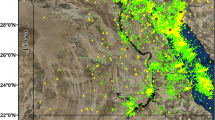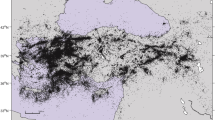Abstract
Discrimination between earthquakes and explosions is an essential component of nuclear test monitoring. However, the discrimination methods currently employed by the Comprehensive Nuclear-Test-Ban Treaty Organization (CTBTO) are sometimes less effective for regional events. For instance, five seismic events whose epicenters lie near the Sea of Galilee were reported by the CTBTO in July of 2018. Those were relatively strong regional events, observed by primary stations hundreds of kilometers from the epicenter. Notably, three out of those five events were not screened out by the CTBTO as natural events. In this work, a diffusion maps-based discrimination method is configured and applied for the July 2018 Sea of Galilee seismic events. New features are introduced to the method, in order to enhance automation and computational efficiency and facilitate its use in operational settings. In the first of which, waveform segments are selected by relying on calculated arrivals rather than observed arrivals, alleviating the need for detection by a human analyst. In a further extension of the method, the low-dimensional diffusion maps representation from the training set is extended to a test set by means of geometric harmonics, relieving the need for the re-calculation of the diffusion maps coordinates for the entire data set as each new event comes in. Utilizing a network of three stations, we show that this machine learning method classifies as earthquakes all the July 2018 Sea of Galilee seismic events with durational magnitude Md > 2.3. In the context of the CTBT, the method can be used as part of an Expert Technical Analysis in order to aid the State Party concerned to identify the source of specific events.








Similar content being viewed by others
Notes
IDC screening does not consider seismic events with mb < 3.5.
CNF are established by Member States cooperative arrangements with the CTBTO, in order to make available to the IDC supplementary data from national monitoring stations that are not formally part of the IMS (CTBT, 1996).
References
Anderson, D. N., Patton, H. J., Taylor, S. R., Bonner, J. L., & Selby, N. D. (2014). Sources of error and the statistical formulation of Ms:Mb seismic event screening analysis. Pure and Applied Geophysics, 171, 537–547.
Ataeva, G., Gitterman, Y., & Shapira, A. (2017). The ratio between corner frequencies of source spectra of P- and S-waves—A new discriminant between earthquakes and quarry blasts. Journal of Seismology, 21(1), 209–220.
Bobrov, D., & Tomuta, E. (2017). Review of the regional high-frequency P to S amplitude ratio provisional screening criterion. Presentation at the Forty-Eighth Session of Working Group B, Vienna, 21 February 2017.
Bregman, Y., Lindenbaum, O., & Rabin, N. (2021). Array based earthquakes-explosion discrimination using diffusion maps. Pure and Applied Geophysics, 178, 2403–2418.
Bregman, Y., & Rabin, N. (2019). Aftershock identification using diffusion maps. Seismological Research Letters, 90, 539–545.
Coifman, R. R., & Lafon, S. (2006a). Diffusion maps. Applied and Computational Harmonic Analysis, 21, 5–30.
Coifman, R. R., & Lafon, S. (2006b). Geometric harmonics: A novel tool for multiscale out-of-sample extension of empirical functions. Applied and Computational Harmonic Analysis, 21, 31–52.
Coyne, J., Bobrov, D., Bormann, P., Duran, E., Grenard, P., Haralabus, G., Kitov, I., & Starovoit, Y. (2012), Ctbto: Goals, networks, data analysis and data availability. In New manual of seismological observatory practice (2nd edn., pp. 1–41), Deutsches Geo Forschungs Zentrum GFZ.
CTBT, Comprehensive Nuclear-Test-Ban Treaty (CTBT) (1996). Retrieved November 17, 2021, from https://www.ctbto.org/the-treaty/treaty-text/.
Del Pezzo, E., Esposito, A., Giudicepietro, F., Marinaro, M., Martini, M., & Scarpetta, S. (2003). Discrimination of earthquakes and underwater explosions using neural networks. Bulletin of the Seismological Society of America, 93, 215–223.
Esposito, A. M., Giudicepietro, F., Scarpetta, S., D’Auria, L., Marinaro, M., & Martini, M. (2006). Automatic discrimination among landslide, explosion-quake, and microtremor seismic signals at Stromboli volcano using neural networks. Bulletin of the Seismological Society of America, 96, 1230–1240.
Ford, S. R., & Walter, W. R. (2014). mb: Ms screening revisited for large events. Bulletin of the Seismological Society of America, 104(3), 1550–1555.
Gasperini, L., Lazar, M., Mazzini, A., Lupi, M., Haddad, A., Hensen, C., et al. (2020). Neotectonics of the sea of galilee (northeast Israel): Implication for geodynamics and seismicity along the Dead Sea Fault system. Scientific Reports, 10(1), 121–129.
Gitterman, Y., Pinsky, V., & Shapira, A. (2003). Improvements in monitoring the CTBT in the Middle East by the Israel Seismic Network. Final Report No. DTRATR-01-35. Defense Threat Reduction Agency.
Haddad, A., Alcanie, M., Zahradník, J., Lazar, M., Antunes, V., Gasperini, L., et al. (2020). Tectonics of the Dead Sea fault driving the July 2018 seismic swarm in the Sea of Galilee (Lake Kinneret), Israel. Journal of Geophysical Research: Solid Earth, 125, e2019JB018963.
Kennett, B. L. N., Engdahl, E. R., & Buland, R. (1995). Constraints on seismic velocities in the Earth from travel times. Geophysical Journal International, 122(1), 108–124.
Kortstrom, J., Marja, U., & Tiira, T. (2016). Automatic classification of seismic events within a regional seismograph network. Computers and Geosciences, 87, 22–30.
Kuyuk, H. S., Yildirim, E., Dogan, E., & Horasan, G. (2011). An unsupervised learning algorithm: Application to the discrimination of seismic events and quarry blasts in the vicinity of Istanbul. Natural Hazards and Earth Systems Sciences, 11, 93–100.
Lindenbaum, O., Bregman, Y., Rabin, N., & Averbuch, A. (2018). Multiview kernels for low-dimensional modeling of seismic events. IEEE Transactions on Geoscience and Remote Sensing, 56, 3300–3310.
Lindenbaum, O., Rabin, N., Bregman, Y., & Averbuch, A. (2020). Seismic event discrimination using deep CCA. IEEE Geoscience and Remote Sensing Letters, 17(11), 1856–1860. https://doi.org/10.1109/LGRS.2019.2959554
Linville, L., Pankow, K., & Draelos, T. (2019). Deep learning models augment analyst decisions for event discrimination. Geophysical Research Letters, 46(7), 3643–3651.
Rabin, N., Bregman, Y., Lindenbaum, O., Ben-Horin, Y., & Averbuch, A. (2016). Earthquake-explosion discrimination using diffusion maps. Geophysical Journal International, 207, 1484–1492.
Reynen, A., & Audet, P. (2017). Supervised machine learning on a network scale: Application to seismic event classification and detection. Geophysical Journal International, 156, 483–496.
Sick, B., Guggenmos, M., & Joswig, M. (2015). Chances and limits of single-station seismic event clustering by unsupervised pattern recognition. Geophysical Journal International, 201, 1801–1813.
Tiira, T. (1996). Discrimination of nuclear explosions and earthquakes from tele-seismic distances with a local network of short period seismic stations using artificial neural networks. Physics of the Earth and Planetary Interiors, 97, 247–268.
Wetzler, N., Shalev, E., Göbel, T., Amelung, F., Kurzon, I., Lyakhovsky, V., & Brodsky, E. E. (2019). Earthquake swarms triggered by groundwater extraction near the Dead Sea Fault. Geophysical Research Letters, 46, 8056–8063.
Funding
The authors declare that no funds, grants, or other support were received during the preparation of this manuscript.
Author information
Authors and Affiliations
Corresponding author
Ethics declarations
Conflict of interest
The authors acknowledge there are no conflicts of interest recorded.
Additional information
Publisher's Note
Springer Nature remains neutral with regard to jurisdictional claims in published maps and institutional affiliations.
Rights and permissions
Springer Nature or its licensor holds exclusive rights to this article under a publishing agreement with the author(s) or other rightsholder(s); author self-archiving of the accepted manuscript version of this article is solely governed by the terms of such publishing agreement and applicable law.
About this article
Cite this article
Bregman, Y., Radzyner, Y., Ben Horin, Y. et al. Machine Learning Based Earthquakes-Explosion Discrimination for Sea of Galilee Seismic Events of July 2018. Pure Appl. Geophys. 180, 1273–1286 (2023). https://doi.org/10.1007/s00024-022-03129-2
Received:
Revised:
Accepted:
Published:
Issue Date:
DOI: https://doi.org/10.1007/s00024-022-03129-2




